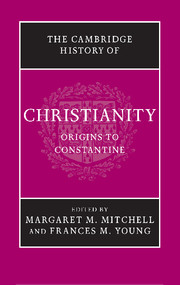Book contents
- Frontmatter
- Prelude: Jesus Christ, foundation of Christianity
- Part I The Political, Social and Religious Setting
- Part II The Jesus Movements
- Part III Community Traditions and Self-Definition
- 8 The emergence of the written record
- 9 Marcion and the ‘canon’
- 10 Self-definition vis-à-vis the Jewish matrix
- 11 Self-definition vis-à-vis the Graeco-Roman world
- 12 Self-differentiation among Christian groups: the Gnostics and their opponents
- 13 Truth and tradition: Irenaeus
- 14 The self-defining praxis of the developing ecclēsia
- Part IV Regional Varieties of Christianity in the First Three Centuries
- Part V The Shaping of Christian Theology
- Part VI ‘Aliens’ become Citizens: towards Imperial Patronage
- Conclusion: retrospect and prospect
- Bibliographies
- Index
- Map 1. The Roman Empire in the time of Marcus Aurelius
- References
13 - Truth and tradition: Irenaeus
from Part III - Community Traditions and Self-Definition
Published online by Cambridge University Press: 28 March 2008
- Frontmatter
- Prelude: Jesus Christ, foundation of Christianity
- Part I The Political, Social and Religious Setting
- Part II The Jesus Movements
- Part III Community Traditions and Self-Definition
- 8 The emergence of the written record
- 9 Marcion and the ‘canon’
- 10 Self-definition vis-à-vis the Jewish matrix
- 11 Self-definition vis-à-vis the Graeco-Roman world
- 12 Self-differentiation among Christian groups: the Gnostics and their opponents
- 13 Truth and tradition: Irenaeus
- 14 The self-defining praxis of the developing ecclēsia
- Part IV Regional Varieties of Christianity in the First Three Centuries
- Part V The Shaping of Christian Theology
- Part VI ‘Aliens’ become Citizens: towards Imperial Patronage
- Conclusion: retrospect and prospect
- Bibliographies
- Index
- Map 1. The Roman Empire in the time of Marcus Aurelius
- References
Summary
Of the several works of Irenaeus mentioned by Eusebius of Caesarea, only two survive in more than fragmentary form. Both are concerned with defending the integrity of the common faith of the universal church. The longer of them, properly entitled Detection and refutation of gnōsis falsely so-called, is usually known simply by the Latin title Adversus haereses (‘Against the heresies’). It survives completely only in a Latin translation, though there are significant fragments of the original Greek and also of an Armenian translation. In the first of its five books, Irenaeus offers a résumé of the teachings of Valentinus and the other heretics he opposes, and in the second a critical analysis of these. In the following three books, Irenaeus sees himself as setting forth the correct interpretation of the scriptural texts which he believes have been distorted or misunderstood in the arguments of the heretics.
The shorter work, called the Demonstration of the apostolic preaching (Epideixis tou apostolikou kērygmatos), which survives only in an Armenian translation, was also intended to help the reader to ‘put to shame all those who hold false opinions’, as well as to ‘set forth our sound and undefiled discourse in all frankness’ for everyone who wanted to know it. Although Irenaeus refers to Adversus haereses towards the end of the Epideixis, it has been suggested that this reference is a later addition, and that the Epideixis was written before Adversus haereses. It is certainly the case that the Epideixis presents us with a much less sophisticated and developed theology than the larger work.
Keywords
- Type
- Chapter
- Information
- The Cambridge History of Christianity , pp. 261 - 273Publisher: Cambridge University PressPrint publication year: 2006

